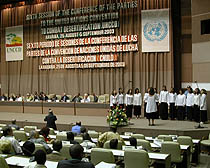
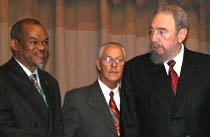
Hama
Arba Diallo, CCD Executive Secretary with Cuba's President Fidel
Castro
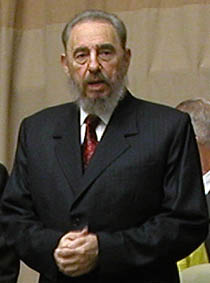
Cuba's
President Fidel Castro
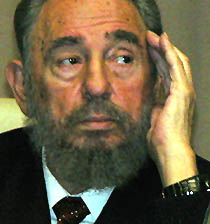
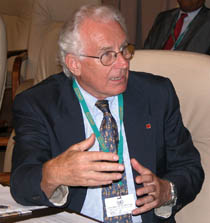

Hama
Arba Diallo, CCD Executive Secretary
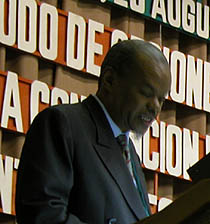
|
CCD
COP-6 HIGHLIGHTS: MONDAY 25 AUGUST, 2003
The Sixth
Conference of the Parties (COP-6) to the Convention to Combat
Desertification (CCD) opened on Monday afternoon, 25 August
in Havana, Cuba. In an opening ceremony, delegates heard statements
from the President of Cuba’s National Assembly and the
CCD Executive Secretary. In the opening Plenary delegates elected
the COP-6 President and other officers including the Chairs
of the CST and CRIC, and adopted the agenda and the organization
of work. Parties also considered accreditation of observer organizations.
OPENING CEREMONY:
COP-6 opened with a musical presentation by Cuban children.
Ricardo Alarcon de Quesada, President of the National Assembly,
stressed his country’s commitment to combating desertification
and supporting the CCD Secretariat in order to ensure success
for COP-6. He hoped the final outcome of the meeting would be
marked not only by good intentions, but also by concrete commitments.
He outlined the impact of desertification and drought in developing
countries, noting that these are closely linked with underdevelopment,
poverty and environmental degradation. He said desertification
is an economic, social and environmental problem that “tests
human survival.” He noted that despite a “very obvious
ecological debt,” there are few commitments on the part
of developed countries to comply with their responsibilities
under Principle 7 of the Rio Declaration on common but differentiated
responsibilities. He outlined successful efforts by Cuba to
combat soil erosion and degradation since 1959, and underscored
the role of governments and civil society in combating land
deterioration to improve the quality of life.
In his opening statement, Hama Arba Diallo, CCD Executive Secretary,
expressed his appreciation to the Cuban Government for hosting
COP-6, and commended the Cuban experience in dealing with rural
poverty. He also thanked other governments, UN agencies and
NGOs for contributing to the session. He highlighted the WSSD
and other processes that “converge” to provide Parties
with “the building blocks of a credible implementation
process,” and singled out the importance of the Global
Environment Facility (GEF) becoming a financial mechanism of
the CCD. Finally, he lauded the CCD’s “quasi-universal”
membership.
OPENING
PLENARY
COP-5 President Charles Bassett (Canada) opened COP-6 and requested
the observation of a minute of silence for Sergio Vieira de
Mello, Special UN Representative to Iraq, and the other UN staff
members who lost their lives in the attack on the UN office
in Iraq on 19 August 2003.
Noting that the WSSD recognized combating desertification as
a major contribution to the reduction of poverty, he stressed
that there is scope for action to reduce poverty and prevent
environmental degradation, and to create opportunities for the
poor to enjoy safer, healthier and more prosperous lives. He
said delegates would work toward better defining the partnership
between the CCD and the GEF in order to provide Parties to the
CCD with the necessary tools to reach effective results. Emphasizing
the need to shift from policy advocacy and institution building
to implementation, he noted that political will should be translated
into the integration of desertification issues with broader
development planning so that national and international resources
could be accessed and used more effectively.
Delegates then elected Rosa Elena Simeón Negrín,
Cuba’s Minister for Science, Technology and the Environment,
as President of COP-6 by acclamation. President Simeón
Negrín expressed hope that COP-6 would make real progress
towards creating a better world, and emphasized that present
unsustainable consumption patterns, especially in the developed
world, must be reversed. Expressing confidence in the ability
of humans to overcome the most difficult of obstacles, she drew
attention to the fact that: 54 countries are poorer today than
in the 1990s; 1.2 billion people live in absolute poverty; 1.3
billion people live on fragile land that does not provide them
with stable livelihoods; food distribution continues to be unequal;
and natural resources are depleted.
CCD Executive Secretary Hama Arba Diallo noted that COP-6 provides
the context to assess the progress of implementing the CCD,
and expressed hope that Parties will take appropriate measures
to translate into action the political commitment to address
desertification and mitigate the effects of drought. He noted
that the ultimate goal is to provide affected countries with
the basic means necessary to implement the CCD and conditions
in arid, semi-arid and dry sub-humid areas are degrading in
many countries.
Observing that climatic and anthropogenic factors increase desertification
and droughts, he said that they must be countered by a more
effective implementation of the CCD. He noted that some 30 African,
16 Asian and seven Latin American and Caribbean countries have
finalized their NAPs. He said the Secretariat has focused on
assisting affected developing countries in the elaboration of
their NAPs, preparation of the national reports submitted to
CRIC-1, and development of a wide range of activities pertaining
to SRAPs and RAPs. He noted that several developing countries
continue to rely on the voluntary contributions channeled by
the Secretariat. He said the Secretariat provided assistance
for all affected countries in Africa, Asia and Latin America
and the Caribbean to participate at CRIC-1. Executive Secretary
Diallo noted that the Secretariat has, inter alia, supported
African countries in preparing for donor consultations aimed
at concluding partnership agreements, and facilitated the preparation
of project proposals on combating desertification under the
New Partnership for Africa’s Development (NEPAD).
 Listen
to: Listen
to:
|
|
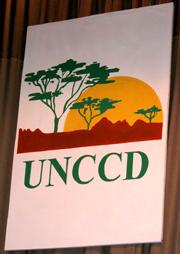
The
UNCCD logo
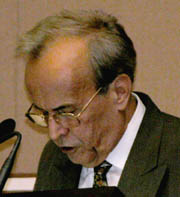
Ricardo
Alarcon de Quesada

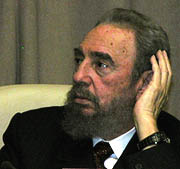
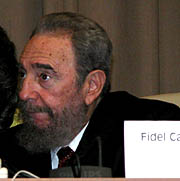
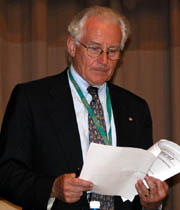
COP-5
President Charles Bassett (Canada) opened COP-6
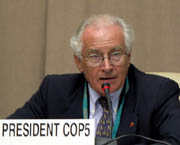
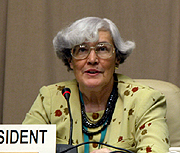
Cop-6
president Rosa Elena Simeón Negrín, Cuba’s
Minister for Science, Technology and the Environment
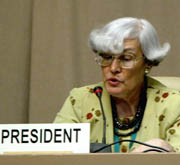
|

